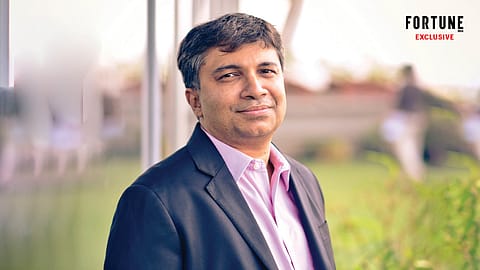Exclusive: Digital is a high growth business for Marico, says MD & CEO Saugata Gupta
The new-age businesses are already contributing 20% to the revenue of its India business and is expected to grow to around 27% in the next couple of years.

Saugata Gupta, MD & CEO of the ₹10,200 crore FMCG major, Marico, likes to call his business a ‘consumer digital’ company. Gupta, who has recently completed 20 years in Marico (which prides itself on being an innovation-led company), has seen it transition from a hair and edible oil business with brands such as Parachute and Saffola to having a significant portfolio of new-age direct-to-consumer food and personal care brands. Marico’s new age portfolio (which includes brands such as Beardo, Plix, Just Herbs, True Elements as well as premium food products under Saffola) which Gupta refers to as ‘diversified business’ is already contributing 20% to the revenue of its India business. He expects it to grow to around 27% in the next couple of years. In 2020, these businesses barely contributed 5%-6% to its overall revenue.
With Beardo and Plix all set to becoming ₹500 crore brands in the next three years, Gupta is certainly happy with how he has approached his new-age businesses. The DTC portfolio of most legacy companies contributes to their overall revenue in low single digits. “In 2017 when we acquired a stake in Beardo, in some of the developed markets DTC was beginning to get market share from traditional brands. We decided to directly participate in the process rather than doing it from a venture capital perspective. We said that we can bring long-term capability to the business. In 2020 we bought Beardo 100% and after that, we started acquiring every year – Just Herbs, Plix and True Elements. Digital business is a high growth business for us,” says Gupta.
Gupta’s rationale behind going aggressive with the new-age digital brands is the realisation that if he ignored it, he would probably lose an opportunity to grow incrementally. “In most companies when the core categories penetration is deep enough, they either premiumise or diversify. If I have a double-digit growth aspiration, revenue-wise, it can’t be done with the core. The core can only grow by mid or low single digits,” he explains.
Though the new-age businesses definitely help in faster revenue growth, Gupta wears his conservative legacy hat and says that the intent is not to chase 50%-60% growth and bleed. “Beardo is profitable, but if I look at similar businesses, their losses are huge. We want to run these businesses with manageable sustainable growth and profit. We expect the digital business to have double-digit EBITDA.”
Gupta has also ensured that his core business and his digital businesses are operated independently. He believes that the mindset and capabilities required are drastically different. In fact, the strategy has been to let the founders run those businesses for at least 3-4 years and then integrate. He has a common logistics, tech stack and even general trade distribution for his DTC brands. “The moment I insource production (for Beardo we have done something), straight away there is 500-600 bps margin movement. Between all the four digital brands there is common logistics, and a common tech stack and we have a huge amount of consumer data. Those are the synergies which I am uniquely placed to do. We are integrating synergies. Also, a common GT for those brands will be much better than trying to use the Marico system. The latter is used to drive mass brands. We have the skill to run two parallel systems and two parallel models,” explains Gupta.
Marico has recently obtained the license to sell its sister concern, Kaya’s products outside of the Kaya clinics. Gupta intends to build Kaya as a digital brand as well as distribute it in premium beauty stores using the DTC distribution platform. “Kaya is an underleveraged brand as it’s sold only through clinics. We see a huge opportunity in growing Kaya on digital.”
All About Food
Recommended Stories
Most personal care companies have got their strategy horribly wrong when they have dabbled in the foods business and vice-versa. Marico too had badly burnt its fingers in food earlier. Gupta claims that its decision to play in premium packaged foods has worked. While its two DTC food forays, Plix and True Elements, are in demand categories such as nutrition and value-added millets which have lot of demand among upmarket consumers, Marico has also been steadily growing its food portfolio under the Saffola brand. Saffola Masala Oats launched way back in 2012-13 is a huge success and the company now a host of products such as honey and soya chunks to name a few. “Food has a huge runway to grow, but I don’t think I will have distribution like Britannia or Maggi. We are clear we don’t have a right to win in mass such as staples or biscuits. Saffola is predominantly for the urban consumer and hence there is a lot of focus on modern trade, e-commerce and probably the top 10,000 general trade outlets,” explains Gupta.
Even when it comes to distributing its DTC food brands on general trade, the strategy has been to focus on just 5-6 SKUs (stock-keeping units). “We believe it is easy to distribute in general trade, but it is difficult to do offtakes. If I have 200 SKUs, I can easily buy distribution, and put up a nice display but that doesn’t mean offtake will happen. We are extremely careful.
Marico, says Gupta, has also been careful in choosing which category of food to be in. Just because they have soya chunks didn’t mean that they would be in frozen soya food too. “We need to participate in something where we have a right to win. We don’t want to be in cold chain, we don’t have the capability.”